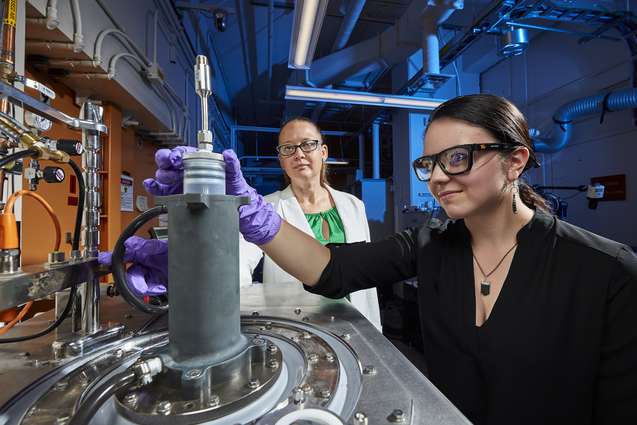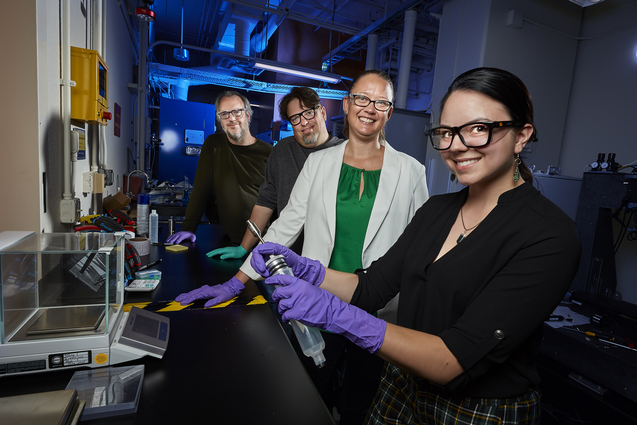Georgia Tech duo spends summer at LLNL exploring materials processing and manufacturing
Professor Blair Brettmann from the Georgia Institute of Technology and her doctoral student Alexa Dobbs decided to spend a summer at Lawrence Livermore National Laboratory (LLNL) to collaborate with the Lab’s materials science experts and learn more about LLNL’s experimental resources. During Brettmann’s faculty mini-sabbatical, she collaborated with researchers from LLNL’s Energetic Materials Center to refine material manufacturing techniques.
According to LLNL materials scientist Kyle Sullivan, who sponsored Brettmann’s mini-sabbatical, she helped his team take a fresh look at their methodology, enabling them to identify ways to streamline a highly complex process.
“Many of our material development activities start with multi-faceted problems,” Sullivan said. “We were eager to draw from Blair’s experience in pharmaceutical manufacturing to help us identify an efficient methodology to apply to our research.”
Brettmann’s research focuses on material processing, including how a material’s properties influence the optimal processing approach, as well as how novel processing techniques can be used to develop materials with the features needed for specific applications. Her goal is to better understand options for real-time monitoring of material processing, including effective data collection tools, as well as knowing which experimental data would be beneficial to analyze. As she heads back to Georgia Tech to start another academic year, Brettmann is hoping that the insight she gained during her mini-sabbatical will help her research team as they test new analytical techniques for their material formulation experiments.
Dobbs spent her summer at LLNL investigating material formulation techniques. She helped design and conduct experiments that explored ways to optimize material mixing and she developed a new process for analyzing experimental data.
During her internship, Dobbs met with LLNL experts in materials processing and advanced manufacturing, who helped her frame her experiments.
“It was great to expand my understanding of the entire manufacturing process and learn about key challenges in the field," Dobbs said. “The opportunity to spend time with energetics experts was one of the highlights of my internship experience.”
LLNL scientist Zac Doorenbos served as Dobbs’ primary mentor during her internship, meeting with Dobbs on a regular basis to review her experimental plans and results.
“Her work helped advance our team’s understanding of our mixing process,” he said.
Doorenbos also trained Dobbs to use a Resonant Acoustic Mixer which LLNL researchers have used for several years. Georgia Tech recently purchased this type of mixer to support their own research. According to Brettmann, as she and Dobbs return to their university, they will be ready to hit the ground running once the new mixer is installed on campus.
Dobbs is earning a doctoral degree in chemical engineering at Georgia Tech, and will be able to use what she learned at LLNL as she continues to explore vibrational mixing processes.
“It was fascinating to see how highly viscous materials can be readily mixed into a paste using vibrational energy,” Dobbs said. “Zac was instrumental in helping me learn how to operate the RAM mixer and understand the different mixing modes, including what needs to happen to materials before they are ready to use.” Dobbs said she hopes to return to LLNL next summer for another internship.
As Brettmann heads back to Georgia to start another academic year, she is eager to dive back into her research and teaching. She also hopes to build on the connections she established during her mini-sabbatical to explore future collaborations with LLNL staff, which will help Georgia Tech faculty and students have opportunities to expand their research portfolios.
“We were pleased to be able to host both Blair and Alexa this summer,” Sullivan said. “While this is the first time my team has hosted a faculty member and student together, it was very successful. We hope that they will be able to bring back new knowledge to their university, and we know that they enriched our research environment as well.”
Brettmann shared her knowledge with LLNL staff, postdocs and student interns through a seminar she delivered at LLNL during her mini-sabbatical. The seminar focused on a systematic approach to material design, which emphasizes coupling material formulation and processability to achieve a better outcome.
“We are always thrilled to host faculty and students at LLNL,” said Manyalibo (Ibo) Matthews, who leads LLNL’s Materials Science Division. “These types of engagements help us build bridges that can foster ongoing collaborations, establish hiring pipelines and bolster capabilities in areas that are critical to our mission.”
–Lisa Valdez
Contact
 Anne M. Stark
Anne M. Stark
[email protected]
(925) 422-9799
Tags
Advanced Materials and ManufacturingPhysical and Life Sciences
Community Outreach
Materials Science
Science
Featured Articles









